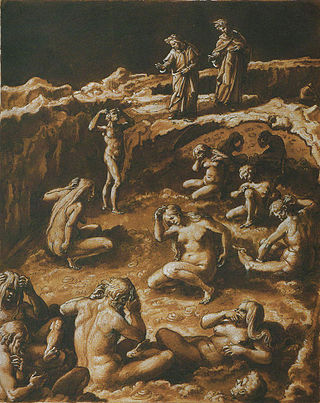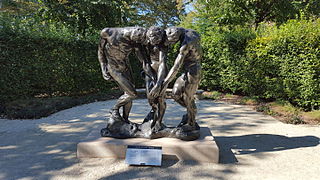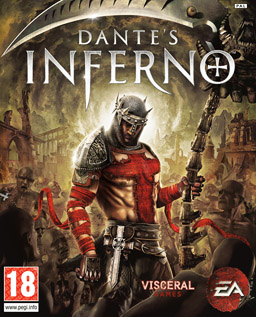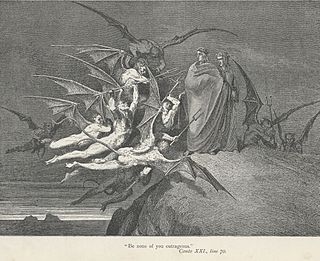
The Divine Comedy is an Italian narrative poem by Dante Alighieri, begun c. 1308 and completed around 1321, shortly before the author's death. It is widely considered the pre-eminent work in Italian literature and one of the greatest works of world literature. The poem's imaginative vision of the afterlife is representative of the medieval worldview as it existed in the Western Church by the 14th century. It helped establish the Tuscan language, in which it is written, as the standardized Italian language. It is divided into three parts: Inferno, Purgatorio, and Paradiso.

In Greek mythology, Charon or Kharon is a psychopomp, the ferryman of Hades, the Greek underworld. He carries the souls of those who have been given funeral rites across the rivers Acheron and Styx, which separate the worlds of the living and the dead. Archaeology confirms that, in some burials, low-value coins were placed in, on, or near the mouth of the deceased, or next to the cremation urn containing their ashes. This has been taken to confirm that at least some aspects of Charon's mytheme are reflected in some Greek and Roman funeral practices, or else the coins function as a viaticum for the soul's journey. In Virgil's epic poem, Aeneid, the dead who could not pay the fee, and those who had received no funeral rites, had to wander the near shores of the Styx for one hundred years before they were allowed to cross the river.
In Greek mythology, the river Phlegethon or Pyriphlegethon was one of the five rivers in the infernal regions of the underworld, along with the rivers Styx, Lethe, Cocytus, and Acheron. Plato describes it as "a stream of fire, which coils round the earth and flows into the depths of Tartarus". It was parallel to the river Styx. It is said that the goddess Styx was in love with Phlegethon, but she was consumed by his flames and sent to Hades. Eventually, when Hades allowed her river to flow through, they reunited.
Terza rima is a rhyming verse form, in which the poem, or each poem-section, consists of tercets with an interlocking three-line rhyme scheme: The last word of the second line in one tercet provides the rhyme for the first and third lines in the tercet that follows. The poem or poem-section may have any number of lines, but it ends with either a single line or a couplet, which repeats the rhyme of the middle line of the previous tercet.

Purgatorio is the second part of Dante's Divine Comedy, following the Inferno and preceding the Paradiso. The poem was written in the early 14th century. It is an allegory telling of the climb of Dante up the Mount of Purgatory, guided by the Roman poet Virgil – except for the last four cantos, at which point Beatrice takes over as Dante's guide. Allegorically, Purgatorio represents the penitent Christian life. In describing the climb Dante discusses the nature of sin, examples of vice and virtue, as well as moral issues in politics and in the Church. The poem posits the theory that all sins arise from love – either perverted love directed towards others' harm, or deficient love, or the disordered or excessive love of good things.
Barbariccia is one of the demons in the Inferno of Dante Alighieri's Divine Comedy. Barbariccia is one of the Malebranche, whose mission is to guard Bolgia Five in the Eighth Circle, the Malebolge. Barbariccia's name means "curly beard" in Italian. Barbariccia seems to be the most important devil after Malacoda as he becomes the "provost" of nine other devils, when Malacoda commands them to escort Dante and Virgil, which can be read out of the following text :

In Dante Alighieri's Inferno, part of the Divine Comedy, Malebolge is the eighth circle of Hell. Roughly translated from Italian, Malebolge means "evil ditches". Malebolge is a large, funnel-shaped cavern, itself divided into ten concentric circular trenches or ditches. Each trench is called a bolgia. Long causeway bridges run from the outer circumference of Malebolge to its center, pictured as spokes on a wheel. At the center of Malebolge is the ninth and final circle of hell.

Ciampolo is the accepted name of a character in Dante's Divine Comedy.

Iacopo Rusticucci was a Guelph politician and accomplished orator who lived and worked in Florence, Italy in the 13th century. Rusticucci is realized historically primarily in relation to the Adimari family, who wielded much power and prestige in thirteenth-century Florence, and to whom it is thought Rusticucci was a close companion, representative, and perhaps lawyer. Despite his association with men born into high political and social rank, Rusticucci was not born into nobility, and nothing is known of his ancestors or predecessors. The exact dates of his birth and death are unknown.

The Divine Comedy has been a source of inspiration for artists, musicians, and authors since its appearance in the late 13th and early 14th centuries. Works are included here if they have been described by scholars as relating substantially in their structure or content to the Divine Comedy.

The Wood of the Self-Murderers: The Harpies and the Suicides is a pencil, ink and watercolour on paper artwork by the English poet, painter and printmaker William Blake (1757–1827). It was completed between 1824 and 1827 and illustrates a passage from the Inferno of the Divine Comedy by Dante Alighieri (1265–1321). The work is part of a series which was to be the last set of watercolours Blake worked on before his death in August 1827. It is held in the Tate Gallery, London.

Dante's Inferno is a 2010 action-adventure game developed by Visceral Games and published by Electronic Arts. The game was released for PlayStation 3, Xbox 360 and PlayStation Portable in February 2010. The PlayStation Portable version was developed by Artificial Mind and Movement.

Inferno is the first part of Italian writer Dante Alighieri's 14th-century epic poem Divine Comedy. It is followed by Purgatorio and Paradiso. The Inferno describes Dante's journey through Hell, guided by the ancient Roman poet Virgil. In the poem, Hell is depicted as nine concentric circles of torment located within the Earth; it is the "realm ... of those who have rejected spiritual values by yielding to bestial appetites or violence, or by perverting their human intellect to fraud or malice against their fellowmen". As an allegory, the Divine Comedy represents the journey of the soul toward God, with the Inferno describing the recognition and rejection of sin.
Calcabrina is one of the demons featured in Inferno, the first canticle of Dante Alighieri's Divine Comedy. Calcabrina's name is possibly meant to mean "grace-stomper" or "frost trampler."

Dante's Inferno: An Animated Epic is a 2010 adult animated dark fantasy film. Based on the Dante's Inferno video game that is itself loosely based on Dante's Inferno, Dante must travel through the circles of Hell and battle demons, creatures, monsters, and even Lucifer himself to save his beloved Beatrice. The film was released on February 9, 2010.

"Pape Satàn, pape Satàn aleppe" is the opening line of Canto VII of Dante Alighieri's Inferno. The line, consisting of three words, is famous for the uncertainty of its meaning, and there have been many attempts to interpret it. Modern commentators on the Inferno view it as some kind of demonic invocation to Satan.

The Malebranche are the demons in the Inferno of Dante's Divine Comedy who guard Bolgia Five of the Eighth Circle (Malebolge). They figure in Cantos XXI, XXII, and XXIII. Vulgar and quarrelsome, their duty is to force the corrupt politicians (barrators) to stay under the surface of a boiling lake of pitch.

Alichino is one of the devils in the Inferno of Dante Alighieri's Divine Comedy. Alichino is a member of the Malebranche, whose mission is to guard Bolgia Five in the Eighth Circle, the Malebolge. Alichino's name is commonly regarded as a garbled version of the Italian word for harlequin, Arlecchino, perhaps for his flying attempt to catch Ciampolo of Navarre in his escape. His only significant contribution to the plot is when he persuades the other devils to leave Ciampolo of Navarre alone. Ciampolo is supposed to summon other sinners from the lake of boiling pitch, on request by Dante. But Ciampolo doesn't call at his friends. Instead, he fools the devils and escapes back to the lake, and Alichino tries in vain to catch him. This causes a fight between Alichino and Calcabrina, which causes them to fall into the lake. The other devils put the blame on Virgil and Dante, though and hunt them vexed.

"Raphèl mai amècche zabì almi" is a verse from Dante's Inferno, XXXI.67. The verse is shouted out by Nimrod, one of the giants who guard the Ninth Circle of Hell. The line, whose literal meaning is uncertain, is usually interpreted as a sign of the confusion of the languages caused by the fall of the Tower of Babel.

The great refusal is the error attributed in Dante's Inferno to one of the souls found trapped aimlessly at the Vestibule of Hell. The phrase is usually believed to refer to Pope Celestine V and his laying down of the papacy on the grounds of age, though it is occasionally taken as referring to Esau, Diocletian, or Pontius Pilate, with some arguing that Dante would not have condemned a canonized saint. Dante may have deliberately conflated some or all of these figures in the unnamed shade.
















